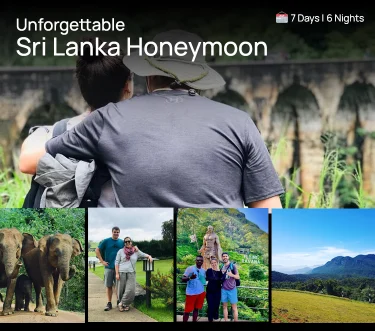8 Sacred Temples of Sri Lanka: A Spiritual Journey through History and Devotion
Sri Lanka is often called the Pearl of the Indian Ocean not only for its natural beauty but also for its rich tapestry of spiritual heritage. Dotted across its lush landscape are ancient temples and sacred sites where history and faith intertwine. Pilgrims draped in pure white walk barefoot on sun-warmed stones, monks chant prayers that echo through incense-laden air, and century-old rituals continue to thrive in the modern day. Visiting these most sacred temples in Sri Lanka is more than a sightseeing trip – it’s a journey into the soul of a nation, one filled with reverence, legend, and living tradition.
In this comprehensive guide, we explore Sri Lanka’s holiest temples – each a treasure trove of devotion and culture. We’ll maintain the storytelling charm and emotional depth of each site while enhancing readability with bullet-point highlights. Take a deep breath and step with us into these hallowed grounds, where every stone has a story and every ritual carries the weight of centuries.
Temple of the Sacred Tooth Relic (Sri Dalada Maligawa, Kandy)
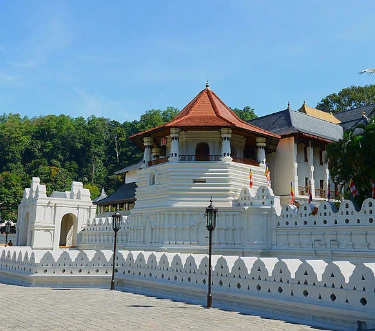
The Temple of the Sacred Tooth Relic illuminated at dusk in Kandy – Sri Lanka’s spiritual heart. The Temple of the Sacred Tooth Relic in the hill capital of Kandy is perhaps the most revered Buddhist site in Sri Lanka. Locally known as Sri Dalada Maligawa, it enshrines the sacred tooth of Lord Buddha within its golden-roofed sanctum. This temple lies within the royal palace complex by Kandy’s serene lake, and its significance in Sri Lankan culture is immeasurable – a belief holds that whoever keeps the relic holds the governance of the country, a concept that influenced ancient kings for centuries. Walking into the temple, you’ll be greeted by the rhythmic beat of drums and the fragrance of lotus flowers offered by devotees, setting a tone of deep sanctity and awe.
- Houses a Sacred Relic: The temple safeguards Buddha’s tooth relic, a venerated object drawing pilgrims from around the world en.wikipedia.org. Devotees often queue for a glimpse of the gold casket that encases the relic, their palms pressed together in prayer as they inch forward.
- UNESCO World Heritage Site: Recognized for both its cultural value and Kandyan architecture, the complex features carved wooden pillars, sloping tiled roofs, and a stunning golden canopy built over the main shrine en.wikipedia.org. The walls are adorned with intricate paintings and gilded decorations that reflect the artistry of the Kandyan kingdom.
- Daily Rituals and Annual Festival: Worship ceremonies (pujas) are conducted three times a day – at dawn, mid-day, and evening – accompanied by traditional drumming and trumpeting. On Wednesdays, a symbolic bathing of the relic with herbal scented water (Nanumura Mangallaya) is performed; this holy water is later distributed to devotees for blessings en.wikipedia.org. Each summer (July/August), the city erupts in pageantry during the Esala Perahera festival, when the relic’s casket is paraded atop an elephant through Kandy’s streets amid dancers, fire-breathers, and musicians in one of Asia’s grandest religious processions.
- Atmosphere of Devotion: Stepping inside, you’ll feel a profound sense of peace and reverence. The air is thick with the aroma of incense and fresh jasmine and lotus flowers offered at various altars. The sound of the traditional drums (hevisi) during prayer times resonates in your chest. Despite often drawing large crowds, the experience can feel deeply personal – many visitors describe an intimate spiritual connection as they stand before the inner chamber, eyes closed in meditation or filled with tears of joy.
Standing in this temple during the evening puja, one can feel the spiritual heartbeat of Sri Lanka – a humbling connection between past and present, devotion and hope.
Rangiri Dambulla Cave Temple (Golden Temple of Dambulla)
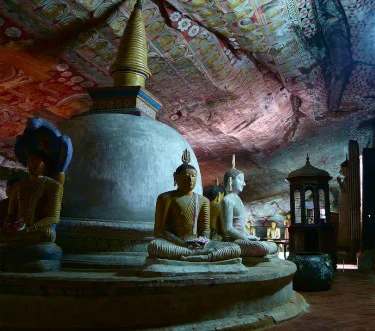
Inside Dambulla Cave Temple – rows of serene Buddha statues and painted ceilings in the ancient rock caves. In the central plains of Sri Lanka rises Dambulla Rock, a massive outcrop that shelters a magical underground world of worship. The Rangiri Dambulla Cave Temple, also known as the Golden Temple of Dambulla, has been a sacred refuge and pilgrimage site for over two thousand years. From outside, the climb up stone steps offers sweeping views of the countryside – green jungle stretching to the horizon and the famous Sigiriya rock fortress visible in the distance. But it’s inside the caves that Dambulla truly captivates: entering the dimly lit grottoes, you’re surrounded by hundreds of statues and vivid murals, with the cool rock ceiling painted in intricate patterns overhead. It feels like stepping into a timeless sanctuary of art and faith.
- Ancient Cave Sanctuary: Dambulla is the largest and best-preserved cave temple complex in Sri Lanka en.wikipedia.org, consisting of five main caves converted into shrine rooms. Within these caves are over 150 statues of Buddha (ranging from small figurines to a colossal 15-meter reclining Buddha) as well as statues of Hindu gods and ancient kings en.wikipedia.org. Every surface—from the undulating ceilings to the curving walls—is covered in vibrant Buddhist murals depicting scenes from the Buddha’s life, including celestial visions and battles with demons.
- Historical Significance: The origins of the temple date back to the 1st century BC. Legend tells that King Valagamba of Anuradhapura, exiled from his throne, found refuge in these very caves. When he regained his kingdom, he showed his gratitude by transforming the caves into a magnificent temple, funding extensive carvings and artwork. Over the centuries, successive kings (even up to the Kandyan period in the 18th century) added to the splendor, so the artwork spans many eras. This continuity of devotion is palpable as you move from cave to cave.
- Otherworldly Atmosphere: Inside the caves, a serene hush prevails. The chambers are illuminated by soft golden light that glints off the gilded statues. Stalactites hang from the cave roof, often appearing as if they merge with painted lotuses and deities on the ceiling. The murals cover about 2,100 square meters of surface en.wikipedia.org – an area so vast that absorbing all the details is nearly impossible, yet every glance unveils a new detail, be it a figure of a meditating monk or a gentle lotus motif. Monks and locals from the nearby village occasionally drift in to light an oil lamp or meditate in a corner, adding to the sense of living sanctity.
- UNESCO Heritage Site & Views: Dambulla’s significance was recognized by UNESCO, and it became a World Heritage Site in 1991. Beyond the art inside, the site’s location is spectacular – the rock towers 160 meters above the plains en.wikipedia.org. After exploring the interior, many visitors step out to a panoramic lookout point near the caves’ entrance. Here, with a gentle breeze on your face, you can gaze out at the verdant landscape and distant mountains, reflecting on the historical and spiritual journey Dambulla represents.
The cool interior of Dambulla’s caves, lit by flickering lamps and filled with Buddha images at every turn, leaves you with a sense of wonder. It’s as if the very rock is alive with the devotion of ages, a place where art, history, and faith are eternally intertwined.
Kataragama Temple (Ruhunu Maha Kataragama Devalaya)
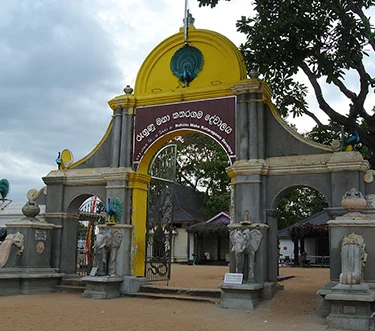
Pilgrims at the Kataragama Temple lighting oil lamps at dusk – a sacred meeting point of multiple faiths. Tucked away in the deep south of Sri Lanka is Kataragama, a holy town that is a beacon of interfaith pilgrimage. Here, the Kataragama Temple (also known as Ruhunu Maha Kataragama Devalaya) is unique in that it is venerated by Buddhists, Hindus, Muslims, and the indigenous Vedda people alike rofi.lk. A visit to Kataragama is often described as an intense spiritual experience – one filled with the sound of devotional songs, the heat of camphor flames, and the sight of thousands of devotees united in faith and fervor. It’s said that every Sri Lankan aspires to worship at Kataragama at least once in their lifetime, such is the shrine’s profound significance.
- Temple for All Faiths: The Kataragama shrine complex is dedicated primarily to Lord Skanda-Murugan (Kataragama Deviyo), the Hindu war god, who is believed to preside here. Buddhists revere the site as well, as one of the sixteen places Lord Buddha visited during his legendary visits to Sri Lanka en.wikipedia.org. Within the complex, you’ll find a Hindu temple to Skanda, a Buddhist stupa (the white-domed Kiri Vehera just behind the main temple), and even a nearby mosque – reflecting the multi-religious tapestry of Kataragama. It’s a moving sight to see saffron-robed monks, Hindu priests, and Sufi dervishes all present in this sacred locale.
- Legend and Lore: According to Hindu lore, Kataragama is where Lord Murugan wed Walli, a local Vedda princess – a tale celebrated in temple lore and dance. Another tale from Buddhist tradition holds that Lord Buddha, on his third visit to Sri Lanka, met the local king of Kataragama and preached the Dharma here, thereby sanctifying the ground. These overlapping stories contribute to an aura of myth and mystery; every boulder and tree in the area seems to have a legend attached.
- Vibrant Annual Festival: If you visit during July/August, you may witness the spectacular Kataragama Esala Festival, one of the most electrifying religious festivals in Sri Lanka. For two weeks, thousands of pilgrims converge – many having walked for days or weeks on foot to get here. The rituals include fire-walking ceremonies, dragging chariots, and the famous Kavadi dance where devotees carry ornate frameworks or even pierce their skin with hooks and skewers as acts of devotion and penance. Each evening, a grand procession winds through the town with whip-crackers, drummers, dancers, and a colorful palanquin carrying the god’s spear (vel). The energy, especially on the final night’s water-cutting ceremony at the Menik River, is indescribable – faith in its most passionate form.
- Devotional Atmosphere: On any given day, the temple courtyard is a hive of spiritual activity. Devotees break coconuts on the ground as offerings (the shattering of coconut symbolizing the breaking of one’s ego in devotion). Others light clay oil lamps or offer fruits on brass trays to the deity. The fragrance of burning incense and jasmine garlands mingles with the smoke of camphor. You might hear pilgrims cry out “Haro Hara!” in praise of Murugan. Despite the crowds and intensity, there’s a remarkable sense of communal harmony – people of different religions and ethnicities all find blessing under Kataragama’s sacred aegis.
Whether you come as a devotee or an observer, Kataragama’s spiritual energy is all-encompassing. The sight of faith in multiple forms – a Buddhist silently meditating by the stupa, or a Hindu trance-dancing to the drumbeat – offers a powerful reminder of the diversity and depth of Sri Lanka’s devotional heart.
You can book your tour with Lanka Tour Driver to enjoy the venu, Check our Packages
Jaya Sri Maha Bodhi (Sacred Bodhi Tree, Anuradhapura)

The sacred Bodhi Tree of Anuradhapura, supported by gilded railings and surrounded by prayer flags and devotees. In the ancient city of Anuradhapura, amid towering stupas and monastery ruins, lives a revered being that has stood alive for over two millennia. The Jaya Sri Maha Bodhi is not a man-made temple but a sacred Bodhi fig tree – a direct descendant grown from a cutting of the very tree under which Gautama Buddha attained enlightenment in India. Planted in 288 BC, this is the oldest living tree in the world documented with a recorded planting date guinnessworldrecords.com. To Sri Lankan Buddhists, and Buddhists worldwide, it is a living link to the Buddha himself and a symbol of enlightenment, peace, and continuity.
- Oldest Human-Planted Tree: For over 2,300 years, this Bodhi tree has been tended with the utmost care and devotion guinnessworldrecords.com. It was brought as a sapling from Bodh Gaya by Princess Sangamitta, the daughter of Emperor Ashoka, in the 3rd century BC – a momentous event in Buddhist history. Kings, monks, and laypeople alike have protected this tree through the ages, even building support pillars and gold-plated railings to help uphold its aging branches. When you gaze upon it, you’re looking at a living organism that has silently witnessed the rise and fall of kingdoms.
- Sacred Atmosphere: The area around Jaya Sri Maha Bodhi is arranged in terraces, with the tree itself on the highest platform, fenced off by golden rails. Devotees approach barefoot, bearing offerings of flowers, usually fragrant frangipani and lotus blossoms, which they place on altars at the foot of the terrace. Many bring buckets of water to gently pour onto the tree’s roots – a symbolic act of giving sustenance to the tree that, in turn, sustains their faith. Colorful prayer flags flutter from the branches, tied by pilgrims as wishes or in memory of loved ones. The atmosphere is one of profound serenity and reverence: often you’ll hear the soft murmur of Pirith chanting by monks, and the rustling of leaves in the breeze sounds like a gentle whisper of blessings.
- Historical Significance: This Bodhi tree has been central to Sri Lanka’s Buddhist heritage. Around it, the ancient capital Anuradhapura grew, and it was a place of coronation vows for kings in antiquity (rulers would symbolically seek the tree’s blessing to legitimize their reign). The tree has miraculously survived attempts of destruction – from invading armies to storms – which only reinforced its sacred status. Visiting the Sri Maha Bodhi is not only a spiritual act but also a journey back into Sri Lanka’s deep history; just adjacent are the ruins of monasteries and stone inscriptions that are among the oldest in the country.
- Experience of Tranquility: Unlike enclosed temples, here worship happens under the open sky, beneath spreading branches. As sunlight filters through the Bodhi leaves, you may feel a deep calm. It’s common to see devotees sitting cross-legged in meditation around the tree, eyes closed, completely at peace. Even travelers from afar often sense a special aura here – many describe feeling goosebumps or an emotional uplift knowing the age and origin of this tree. It’s a must-visit for anyone seeking to understand the spiritual resilience of Sri Lanka.
In the presence of the Jaya Sri Maha Bodhi, time seems to stand still. The gentle rustle of its leaves has serenaded countless generations of pilgrims. To sit in its shade is to feel a direct connection to the moment of Enlightenment – a quietly humbling and inspiring experience that lingers long after you leave.
Munneswaram Kovil Temple (Chilaw)

The ornate gopuram (gateway tower) of Munneswaram Kovil, adorned with colorful deities – a beacon of ancient Hindu worship. Heading west towards Sri Lanka’s coastline, we find Munneswaram Temple, one of the island’s oldest and most venerated Hindu temples. Located in Chilaw, Munneswaram is part of the legendary five ancient temples (Pancha Ishwaram) dedicated to Lord Shiva. This temple complex has been a place of continuous worship for well over a thousand years, surviving colonial eras and remaining a cornerstone of Hindu faith in Sri Lanka. Visitors are often struck by the contrast as they arrive: the bustling market outside with vendors selling garlands and coconuts gives way to a tranquil courtyard inside, dominated by an intricately carved tower that seems to touch the clouds. Munneswaram offers a glimpse into the devotional practices, mythology, and architecture of Sri Lankan Tamil Hindu culture.
- Shiva Temple Complex: Munneswaram is primarily a Shiva temple, honoring Lord Shiva in his form as Ishwara (hence the name Munneswaram, meaning the first or chief Ishwara temple). The sprawling complex actually contains five shrines dedicated to various deities justwravel.com. The central Sivan Kovil (Shiva shrine) is the main focus, featuring a sanctum with a Shiva Lingam. Around it are temples for Ganesha (the elephant-headed god of beginnings), Kali (the fierce mother goddess), Ayyanayake (a local deity often identified with Skanda/Murugan), and even a small Buddhist temple within the grounds justwravel.com. This unique assembly of shrines means that people of different faiths feel welcome here, and it’s not uncommon to see Buddhist devotees respectfully making offerings alongside Hindu worshippers.
- Ramayana Legend: Munneswaram holds a special place in the epic Ramayana lore. Legend says the temple was visited by Lord Rama himself. After defeating the demon-king Ravana in battle, Rama was afflicted by the sin of Brahmahatya (killing a Brahmin, since Ravana was a Brahmin king). Seeking forgiveness, Rama stopped at Munneswaram to pray to Lord Shiva. Pleased by his devotion, Shiva blessed Rama and advised him to install and pray to four lingams (symbolic Shiva stones) across the island to atone for his sin – Munneswaram being the first. This story is why Munneswaram is a pilgrimage stop for many Indian devotees as part of the “Ramayana trail”, and it adds a layer of mythic grandeur to the temple’s status justwravel.com.
- Architectural Splendor: The temple’s architecture is a classic example of Dravidian design found in South Indian temples. Its towering gopuram at the entrance is adorned with a profusion of colorful statues – gods, goddesses, demons, and beasts – all intricately sculpted and painted. As you pass through the gopuram, you enter a spacious open courtyard. The ground underfoot is sandy, and the scent of incense mingles with ocean breezes. The inner halls (mandapams) have ornate granite pillars carved with Hindu mythical motifs. Bells hang from the ceiling, ringing softly as devotees pull on them to announce their prayers to the deities.
- Festivals and Rituals: Munneswaram is active year-round, but it truly comes alive during its annual festival, usually in August/September, which spans 28 days. During this time, the temple hosts vibrant processions each week, traditional drummers and flutists lead devotees around the complex, and a grand chariot carrying the deity is pulled through the streets on the final day. The festivities draw tens of thousands, including Sinhalese Buddhists and Tamil Hindus alike, exemplifying the temple’s inclusive nature. Another important occasion is Maha Shivaratri (usually February), an all-night worship of Lord Shiva, when the temple is adorned with oil lamps and resonant with chants. Even on regular days, you may witness puja ceremonies where priests perform rituals with fire lamps and devotees break coconuts as offerings (a practice symbolizing the breaking of one’s ego to reveal purity within).
- Spiritual Experience: Visiting Munneswaram, you’re likely to feel a sense of peace amid the devotion. Friendly temple guides might tell you about the significance of each shrine or show you how to make an offering. If you come in the evening, the whole temple is bathed in the warm glow of oil lamps, and the sound of devotional music fills the air. Monkeys occasionally scamper across the courtyard, adding a touch of nature’s playfulness to the sacred setting. Whether or not one shares the Hindu faith, spending time at Munneswaram – observing the prayers, the ancient rituals, and the sincere faith of the people – can be a deeply moving experience that underscores the spiritual harmony of Sri Lanka.
Munneswaram’s tranquil courtyards and venerable halls invite you to slow down and reflect. Here, epic mythology and everyday faith meet: one can almost imagine Lord Rama himself kneeling in prayer. The temple’s enduring popularity across communities is a testament to its powerful aura – a place where divine grace is believed to touch the lives of all who come with an open heart.
Nallur Kandaswamy Kovil (Jaffna)
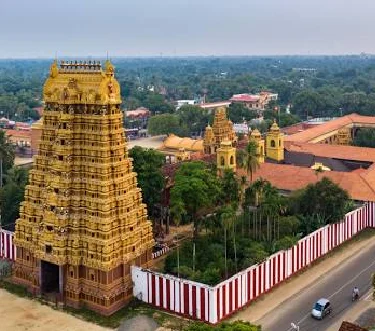
Devotees gathering outside Nallur Kandaswamy Kovil’s ornately sculpted entrance during the annual festival. In the northern city of Jaffna, the Nallur Kandaswamy Kovil stands as a shining jewel of Tamil Hindu culture in Sri Lanka. Dedicated to Lord Murugan (also known as Skanda or Kataragama deviyo, the warrior deity and son of Lord Shiva), Nallur is not just a temple; it’s the spiritual heartbeat of Jaffna’s Hindu community. The very name Nallur means “Good City,” and indeed this temple has been the center around which the local civilization thrived for centuries. The current structure dates back to 1734 (built during the Dutch period after the original was destroyed in colonial conflicts en.wikipedia.orgen.wikipedia.org), and it has been maintained in pristine condition. Approaching Nallur Kovil, you’ll be struck by its long red-and-white striped outer walls and the tall golden-ochre Gopuram that soars above the entrance, covered in elaborate carvings of Hindu gods. Inside, an atmosphere of disciplined devotion and vibrant tradition envelops every visitor.
- Devotion to Lord Murugan: Nallur Kovil is one of the most important Murugan temples in the world, drawing devotees from Sri Lanka and the South Indian Tamil diaspora. The presiding deity is Lord Murugan in the form of the holy Vel (a divine spear weapon) en.wikipedia.org, symbolizing his power. The inner sanctum houses this revered Vel and statues of Murugan with his two consorts Valli and Deivayanai. Around the main shrine, there are also shrines for Lord Ganesha and other forms of Murugan. The temple’s daily routine includes multiple puja ceremonies (at least four main ones a day, from early morning to night), during which brass bells peal and the priests – bare-chested with sacred ash stripes on their skin – perform rituals with lamps and incense. The level of energy during these poojas, especially the noon and evening ones, is both intense and uplifting.
- Festive Granduer – Nallur Festival: If you visit Jaffna in August, the Nallur Kovil’s annual festival is an absolute must-see. Spanning 25 days, it is a spectacular display of faith and community. Each day has its own significance and ceremonies – from the Kavadi dance where devotees carry decorated arches and undergo acts of penance, to the ther (chariot) festival where a massive ornate chariot bearing the temple’s deity is pulled through the streets by hundreds of volunteers amidst chanting and music. One of the most awaited events is the veedi utsavam (street procession) each evening, where Lord Murugan’s idol is taken out of the temple on different vahanas (vehicles) – one day on a jeweled peacock, another day on a silver throne, etc. The final night, known as Ther Thiruvillah, culminates with fireworks and a sea of devotees. The fervor, color, and scale of the Nallur festival are often compared to the great temple festivals of Tamil Nadu, India. Even outside festival season, Nallur often hosts traditional music and dance performances in the temple courtyard, keeping classical art forms alive as offerings to the divine.
- Architectural and Cultural Heritage: The temple showcases elegant Dravidian architecture – though relatively austere compared to the super-ornate South Indian temples. The main hall is an open pillared courtyard with a shining brass roof over the sanctum that glints in the sunlight. The pillars and ceilings are decorated subtly with lotus motifs. There’s no idol in the central shrine, only the Vel weapon, which is unique and symbolic. Around the complex, you’ll notice ponds for ritual bathing and a separate enclosure that houses the temple’s wooden chariots. The order and cleanliness of the premises are notable – the sand ground is swept and watered daily to keep it cool. Strict dress codes are enforced: men must remove their shirts (many male devotees also wear traditional white veshti or sarong when entering) and women should be modestly attired. This adherence to tradition instills a sense of respect and reminds visitors that they are stepping into a very sacred space.
- Spiritual Vibes: Despite Nallur’s popularity and often large crowds, there is an underlying sense of discipline and sanctity in the air. You might hear the melodic sound of the nadaswaram (a classical wind instrument) and drums during pooja times, creating an ambiance that is both festive and reverent. Devotees move clockwise around the temple, stopping to break coconuts at a designated spot (a sign of humility and thanksgiving) or to pray intensely at each shrine. The dedication is palpable – some elderly devotees lie prostrate on the ground in prayer, while young children clasp their hands and whisper mantras taught by their parents. As an outsider, you’ll likely be welcomed warmly as long as you respect the customs. Many travelers describe feeling a deep emotional resonance here, even if they don’t fully understand the rituals – something about the sincerity of faith at Nallur Kandaswamy Kovil leaves a lasting imprint on the heart.
Visiting Nallur Kovil is more than a sightseeing stop; it feels like being invited into a living, breathing cultural masterpiece. The combination of ringing bells, the murmur of Sanskrit hymns, and the sight of devotees gracefully moving through sunlit temple halls creates a tapestry of devotion that is uniquely Jaffna’s own. In the sanctum’s glow, with the Vel of Murugan gleaming, you sense the protection and pride this temple has offered to generations of worshippers – truly an experience of divine heritage.
Gangaramaya Temple (Colombo)
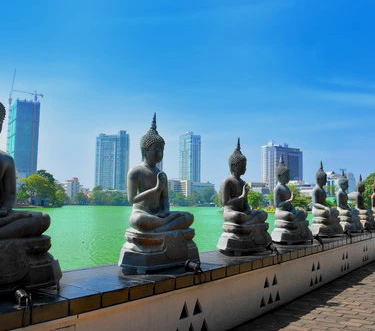
Rows of Buddha statues in Colombo’s Gangaramaya Temple – where tradition meets modernity. Amid the urban buzz of Colombo’s modern skyline lies Gangaramaya Temple, an oasis of spirituality and culture in the heart of Sri Lanka’s largest city. Situated near the tranquil Beira Lake, Gangaramaya is not only a place of worship but also a center of learning and a repository of relics and artworks. Established in the late 19th century, this temple has grown into a complex that reflects a blend of architectural influences and a broad vision of Buddhist charity and education. As you enter, you might be greeted by the sight of gleaming brass statues, the sound of chanting from the main hall, and even the unexpected – like vintage cars and rarities displayed in the temple’s museum section! Gangaramaya is very much a living temple, integral to daily life in Colombo, while also being extremely visitor-friendly.
- Cultural Melting Pot: Gangaramaya’s architecture and design embody a mix of global Buddhist influences. The temple combines Sri Lankan, Thai, Indian, and Chinese architectural elements dustoftheworld.com, making it unique among religious sites in the country. For instance, the main Vihara (sanctum) showcases Sri Lankan Kandyan-style roofs and carvings, while the assembly hall over the lake (Seema Malaka, a separate but affiliated site) was designed by famed architect Geoffrey Bawa, reflecting more minimalist, serene lines. Chinese dragon motifs adorn some doorways, and you’ll even spot Thai-style Buddha images in the corridors. This fusion underscores Colombo’s historic role as a crossroads of trade and culture – Gangaramaya almost feels like a microcosm of Buddhist heritage across Asia.
- Expansive Temple Complex: Despite being in a crowded city, Gangaramaya has an expansive complex. Within its grounds, you’ll find a Dagoba (stupa) draped in prayer flags, a Bodhi Tree with a quiet meditation area, intricately carved temples halls, and various shrines including one dedicated to the Buddhist goddess Tara. One building houses a marvelous museum-like collection of artifacts: there are hundreds of Buddha statues in varying sizes (from inches tall to giant statues) made of stone, wood, brass, and jade – many donated from countries like Thailand, Burma, China, and Japan. The temple’s museum collection also boasts oddities like vintage watches, currency notes, and antique cars gifted by devotees or collectors, showing the eclectic range of what has been offered to the temple over time dustoftheworld.com. Walking through, you get the sense that this is not just a sacred space, but also a guardian of history and culture.
- Community and Learning Center: Gangaramaya is deeply involved in social service and education. It runs training centers for youth in everything from tailoring to IT, a vocational school, an orphanage, and even an elephant care program. As a visitor, you might catch sight of students in white uniforms attending classes within the temple premises, or see announcement boards of charitable programs. This dynamic aspect makes Gangaramaya feel very alive and rooted in the present – a place where religion meets daily life in practical ways.
- Festivals and Events: The temple is famed for two major annual events. The Navam Perahera in February is Colombo’s biggest Buddhist procession: hundreds of monks parade, drummers and dancers perform, and elephants dressed in lavish regalia carry sacred relics through the streets around Gangaramaya, all under the full moon’s light. It’s a spectacle of sound and color that draws huge crowds. Later in the year, during Vesak (May), which commemorates the Buddha’s birth, enlightenment, and passing, Gangaramaya becomes a focal point of celebration. The temple and surrounding streets are adorned with thousands of lanterns and lights; there are stunning pandals (illuminated story displays) and free food stalls for visitors in the true spirit of dāna (charitable giving). Even if you’re not here for those times, almost every Poya (full moon) day sees special activities and higher attendance at Gangaramaya.
- Visitor Experience: Gangaramaya warmly welcomes tourists and pilgrims alike. You may wander freely (except into the most sacred inner shrine during puja times) and take in the mix of quiet corners and buzzing activity. One moment you might be silently observing a lone monk meditating by the Bodhi tree, and the next you’re marveling at a room full of gilded Buddha statues or quaint relics. Dress modestly as with all temples (covering knees and shoulders), and note that shoes must be removed at the entrance (carry them or leave with the attendant). Many visitors also stop by the Seema Malaka floating temple nearby, which is particularly photogenic against the lake. Gangaramaya’s blend of ancient reverence and modern outlook often leaves a deep impression – it shows how Buddhism in Sri Lanka gracefully adapts with time, without losing its core values.
In the midst of Colombo’s energetic pace, Gangaramaya Temple offers a sanctuary of reflection and inspiration. The gentle chiming of bells, the sight of worshippers lighting oil lamps at dusk, and the smiling faces of volunteers and students alike – all of it reinforces a sense of hope and harmony. A visit here not only enriches one’s understanding of Sri Lankan Buddhism but also demonstrates the beautiful ways tradition can live within a contemporary city.
Isurumuniya Temple (Anuradhapura)

- Ancient Origins: As one of the earliest Buddhist sites in Sri Lanka, Isurumuniya carries great historical significance. The temple is set adjacent to the Tissa Wewa (a large reservoir), indicating the close relationship between irrigation, city planning, and monastic life in ancient Anuradhapura. It was a place for meditation and learning. Though small in scale, it likely played a part in the daily spiritual life of the ancient capital, and archaeologists have found inscriptions and relics suggesting royal patronage.
- Famous Rock Carvings: Isurumuniya is renowned for four distinctive carvings, masterpieces of Sri Lankan artistry en.wikipedia.org. The most celebrated is the Isurumuni Lovers sculpture – a Gupta-era style carving of a man and woman in a loving pose, thought to represent a princely couple from legend (many believe it depicts Saliya, son of Emperor Dutugemunu, and the commoner maiden Asokamala, whose love story is part of local lore). This piece, with its graceful lines and enigmatic smile, is displayed in a small museum on-site. Another carving, known as the Elephant Pond, is visible on a rock face by the water: it shows a group of elephants bathing playfully – their trunks and faces emerging from the stone as if from water, capturing a charming, lively moment in stone. A third notable carving often called The Royal Family shows regal figures (perhaps a king and his court) in sophisticated detail. These artworks, over 1500 years old, highlight the skill of ancient craftsmen and are a big draw for visitors interested in art and history.
- Picturesque Setting: Part of Isurumuniya’s allure is its scenic location. The temple is built against a large black rock outcrop. At the base of the rock is a tranquil lotus pond, complete with resident frogs and occasionally visited by bathing elephants from history (or so the carvings suggest!). A carved stone railing and steps lead you up to a terrace where the main shrine is located. Inside the shrine, you’ll find a quiet Buddha image and flickering candles – it’s simple and serene. If you continue up the rock (a short climb aided by steps carved into the stone), you reach a small plateau with an ancient stupa and a panoramic view of the surrounding area, including Tissa Wewa’s shimmering waters through the trees. It’s an ideal spot to sit for a moment, catch the breeze, and feel the peace of this timeless place.
- Peaceful Ambiance: Isurumuniya is often less crowded than the marquee sites like Ruwanwelisaya or the Jaya Sri Maha Bodhi, making it perfect for unhurried exploration. The resident monks and caretakers are friendly; one might offer to show you around the museum or point out a detail you missed in a carving. You might hear the flutter of bird wings echoing in the rock cavity of the temple, or the gentle splash of a fish in the pond. The whole environment encourages you to slow down. Many travelers report that Isurumuniya became one of their favorite spots in Anuradhapura because of this unexpectedly intimate and calming experience amid the larger monuments. It’s a place where you can tangibly feel a connection between nature, art, and devotion.
Isurumuniya Temple may be smaller in stature, but it leaves an indelible mark on those who visit. There’s a romance to this place – in its carvings of lovers and elephants, in the way the afternoon light dances on the pond’s water, and in the echoes of ancient prayers that seem to live in the rocks. Here, one feels the gentle side of Sri Lanka’s spirituality, as soothing and subtle as a watercolor painting, yet profoundly moving.
Frequently Asked Questions
What is the most sacred temple in Sri Lanka?
Sri Lanka has many sacred temples, but the Temple of the Sacred Tooth Relic in Kandy is often considered the most holy. It houses a revered tooth relic of Lord Buddha, making it a focal point of Buddhist pilgrimage. Many Sri Lankans believe their country’s spiritual safety is tied to this relic’s protection. Other incredibly sacred sites include the Jaya Sri Maha Bodhi (the sacred bodhi tree in Anuradhapura) and Ruwanwelisaya Stupa in Anuradhapura, each central to Sri Lanka’s Buddhist heritage.
Are there important Hindu temples I should visit in Sri Lanka?
Yes, Sri Lanka’s cultural heritage includes significant Hindu temples. In this article, we covered Munneswaram Temple (Chilaw) and Nallur Kandaswamy Kovil (Jaffna), which are among the top Hindu sites. Additionally, the country is home to other renowned Hindu temples such as Koneswaram Temple in Trincomalee (an ancient Shiva temple by the sea) and Naguleswaram Temple in Jaffna District – both part of the island’s historic Pancha Ishwaram (five revered Shiva temples). These temples are not only religiously important but also architecturally stunning and tied to local legends.
What should I wear when visiting these sacred temples?
Modest attire is a must when visiting any temple in Sri Lanka. Both men and women should ensure their shoulders and knees are covered (no shorts, short skirts, or sleeveless tops). It’s a good idea to carry a lightweight shawl or scarf which can be used to cover up if needed. At Hindu kovils like Nallur, men are often required to remove shirts (you can wear a sarong or dhoti and go bare-chested as local devotees do, though tourists are usually fine with a covered torso as long as it’s modest). Always remove your shoes and hats before entering temple buildings or sacred areas – there are usually racks or areas to store footwear (or you carry them in a bag). Comfort is key too: since you’ll be barefoot, wearing slip-on shoes and socks (you can wear socks inside some temple premises if the ground is hot) can be helpful.
Do I need to pay any entry fees for these temples?
Many temples are free to enter, especially the active places of worship (and they welcome donations). For example, entry to Kataragama, Nallur, and Gangaramaya temples is typically free. However, some major historic sites that double as tourist attractions have ticket fees. The Temple of the Tooth in Kandy charges an entry fee for foreigners (around LKR 1500, roughly USD $8-10) justwravel.com, and the museum at Gangaramaya has a small fee. The Dambulla Cave Temple requires a ticket as well (about LKR 1500 for foreigners). Always check the latest fees, as they can change. It’s wise to carry some cash in Sri Lankan Rupees; even where there’s no set fee, you might want to offer a donation for temple maintenance or put some money in the donation box after your visit.
What are the do’s and don’ts inside Sri Lankan temples?
A: When visiting, always be respectful of local customs:
Do stay quiet and calm: Avoid loud conversations, and switch your phone to silent. Photography is usually allowed in outer areas, but never use flash on statues or people, and refrain from taking photos during worship or of monks/nuns without permission.
Do remove shoes and hats: as mentioned, this is non-negotiable in sacred areas. Also, never turn your back on a Buddha statue when taking photos (for example, don’t pose with your back to the statue; it’s considered disrespectful).
Don’t point your feet towards Buddhas or shrines while sitting – in Buddhist culture, feet are considered impure, so sit with legs tucked or to the side when in prayer halls.
Do ask if unsure: Temple caretakers or fellow worshippers are generally friendly. If you’re uncertain about anything (like how to receive a blessing, or which areas are off-limits to visitors), a polite inquiry will go a long way.
Don’t smoke or chew gum on temple premises, and of course, do not litter. These are holy grounds that should be kept pure and clean.
Finally, approach each site with an open heart and mind. Whether you’re religious or not, taking a moment to observe or even participate respectfully in the rituals – like lighting an oil lamp or saying a silent wish – can make your visit more meaningful.
By following these guidelines, you’ll not only show respect for Sri Lanka’s sacred places but also enrich your own experience of these timeless spiritual treasures. Enjoy your journey through Sri Lanka’s hallowed halls of worship – it’s sure to be as enlightening as it is unforgettable!
